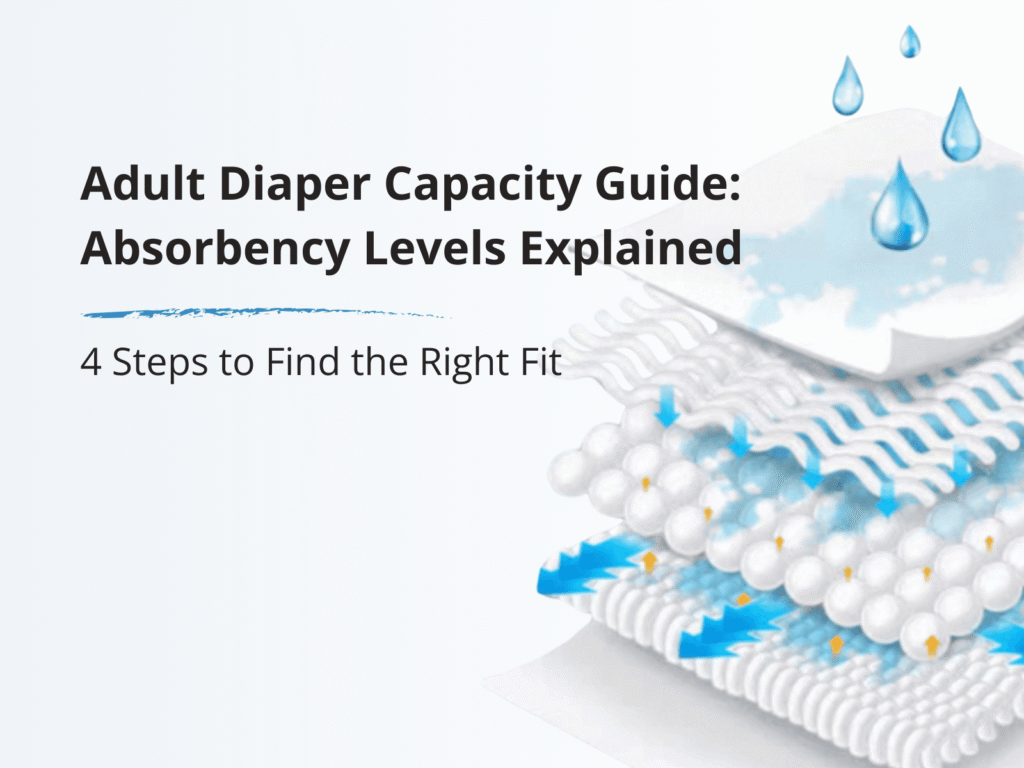
How much pee does an adult diaper hold?
The answer varies: standard adult diapers usually hold about 1–2 urination loads, premium high-absorbency types can manage 6–8 loads, and some top-tier overnight models—like LivDry EnduraDry Max—can reach up to 135 fl oz (16 cups, about 4 liters) in advertised capacity.
When we talk about adult diaper capacity, numbers alone don’t always appear on packages. Most brands prefer to use cups, water drops, or words like Daytime and Overnight. That’s why the first step is not to hunt for a number, but to understand your own incontinence level. Once you know where you stand, you can match yourself directly to the right product label and ensure the adult diaper capacity you choose matches your needs.
Step 1: Find Your Incontinence Level
Understanding adult diaper capacity starts with you. Before comparing numbers or symbols on packaging, first identify which type of incontinence best describes your situation.
| Incontinence Level | Typical Signs |
|---|---|
| Light | Small drips when sneezing, laughing, or exercising. You usually stay dry most of the day. |
| Moderate | Occasional leaks larger than a few drops, but you still have some control. |
| Heavy | Frequent larger leaks, sometimes partial or full bladder release during the day. |
| Overnight / Very heavy | Full loss of control, especially at night or while bedridden, often needing 8–12 hours of protection. |
Once you know which group you belong to, the next challenge is reading what brands actually put on their packaging and how they describe adult diaper capacity.
Step 2: How Brands Describe Capacity
Not every brand measures absorbency the same way. Here are the most common methods you’ll see on the market when comparing adult diaper capacity, with examples from well-known products and guides:
By number of cups – Some listings, such as LivDry MegaBriefs on Amazon, describe capacity in “cups.” One example shows 16 cups (about 135 fl oz) as the maximum advertised absorbency.
By fluid ounces or milliliters – Brands like NorthShore MegaMax publish exact values by size, such as 42–49 oz per brief, which is one of the clearest numeric indicators of adult diaper capacity.
By weight absorption – Retailers such as Target list products like Depend Fresh Protection, highlighting that their absorbent core can hold 30× its weight. This reflects laboratory testing of the material rather than a practical wear-time measure.
By labels and icons – Many guides, such as the Parentgiving Absorbency Levels Explained blog, show that most packages rely on easy terms like Daytime, Overnight or water drop icons (
symbols) instead of numbers.
By urination loads – Some educational resources translate absorbency into how many times an adult can void. Standard diapers are described as handling 1–2 urination loads, premium products 6–8 loads, and top-tier overnight options, sometimes equated to over 67 oz (≈ 2 liters).
These methods may look different, but they all point to the same thing—how much adult diaper capacity the product offers. The real task is to connect these labels to your personal needs.
Step 3: Match Your Level to Market Labels
Having understood the different ways capacity is measured, the next step is to connect those measurements with real packaging terms and symbols. This is where you can translate technical numbers into everyday shopping decisions.
| Your Level | What to Look For on Packaging | Common Symbols & Words | Typical Brand Measure (cups/oz/loads) | Best Fit |
|---|---|---|---|---|
| Light | Daytime / Light Absorbency | 💧 or 💧💧 | ~1–2 urination loads (~200–800 ml) | Slim, discreet, short-term wear |
| Moderate | Super / Plus | 💧💧💧 | 3–4 cups (~700–1000 ml) | Active adults, several hours of protection |
| Heavy | Maximum / Ultra | 💧💧💧💧 | 6–8 loads (1200–2500 ml) | Extended daytime use, fewer changes |
| Overnight / Very Heavy | Overnight / Mega | 💧💧💧💧💧 | Up to 135 fl oz / 16 cups (~4 liters) | Night use, 8–12 hours, maximum security |
Now that you can match your situation with what’s on the package, the next step is to picture how these choices actually work in daily routines and caregiving. This makes the concept of adult diaper capacity more tangible and easier to apply.
Step 4: Real-Life Scenarios
Anna – Active daytime use
She only leaks when sneezing or jogging. Daytime / 💧💧 is enough—lightweight and discreet. Her choice reflects a lower adult diaper capacity, perfect for short wear.James – Moderate daily incontinence
He needs reliable protection for a few hours at work. Super / 💧💧💧 is his best fit. This level of adult diaper capacity balances comfort with stronger protection.Mr. Chen – Overnight protection
As a bedridden patient, he requires all-night dryness. Caregivers use Overnight / 💧💧💧💧💧 for up to 12 hours of security. Here, the highest adult diaper capacity ensures worry-free overnight care.
These scenarios show how the same logic applies to different lifestyles. Whether you’re active, working, or bedridden, the principle is always the same: start from your needs, then read the labels
Putting Capacity Into Practice
All of these examples show how adult diaper capacity is described in the wider market, and it can sometimes feel confusing for buyers.
At Glory, we make this simpler. Our product lines are organized into clear levels—light, moderate, heavy, and overnight—so users and caregivers don’t have to guess.
For example, our adult briefs (tape-style adult diapers) are designed for heavy to overnight use, while our adult pull-up pants provide a discreet option for daytime mobility.
For partners with special requirements, such as nursing homes needing higher SAP ratios for extended night shifts, or retailers looking for thinner designs for active adults, we also provide OEM/ODM customization. This way, capacity is not just a number on a package, but a solution matched to real-world needs.

 symbols) instead of numbers.
symbols) instead of numbers.
